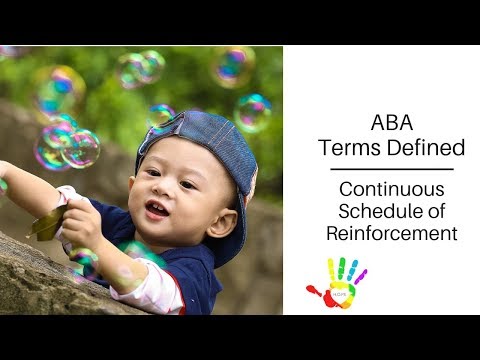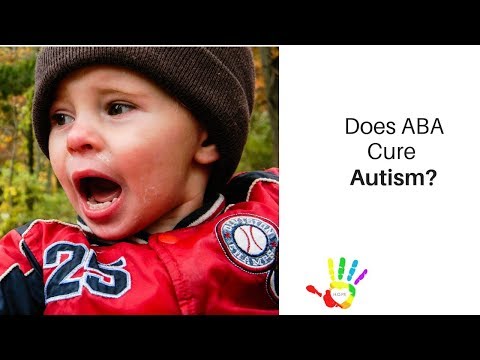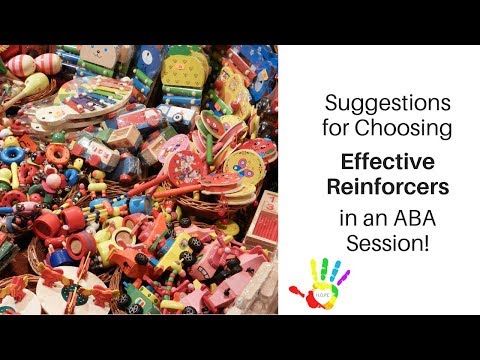https://www.youtube.com/watch?v=TctcmuOdJuY Did you know that the kids with Autism who benefit the ABA therapy are the ones whose parents have the best understanding of the techniques used by their therapist. This video is part of a very special series called ABA Terms Defined. It is designed to help parents like you understand the terms your therapist is using so you can have better conversations with your therapist and carryover the techniques he uses at home. This video describes the term, continuous schedule of reinforcement.
This video is intended for information purposes only. It is not intended to diagnose or treat any medical condition. The text, graphics, images, flash movies, and audio segments are not intended to be a substitute for professional medical advice, diagnosis, or treatment. Always seek the advice of your physician or other qualified health provider with any questions you may have regarding a medical condition.
The information contained in this segment is generalized. It may not be applicable in every situation. Before applying specific interventions, consult a behaviorist. Any behavior intervention can result in an undesired change in behavior if not implemented correctly. No client relationship is established as a result of watching these videos. Jessica Leichtweisz and Hope Education cannot be held responsible for any misuse of the information contained in these videos. <br> <h3>Auto Generated Captions</h3>
[Music]
hey guys my name is Jessica likewise I’m
the CEO of hope education services well
I am passionate about helping parents
just like yours get a really good
understanding of what a BA is and how to
help their kids with autism did you know
that the parents that or excuse me the
children that are the most successful in
any ABA program are the ones who have
the parents who understand the most
about what they learn and participate
the most in ABA sessions so that’s why
I’ve created these videos and this is
part of a very special series called
ABA terms defined and we’re going to
talk a little bit about some of the
terms that your therapist is using to
make sure you understand them so when
you you can ask really great
conversation their questions when you’re
having conversations and to make sure
you can carry out what they’re doing so
the term we’re going to be defining in
this video is called continuous
reinforcement well what is that now I
just want to say ABA therapists we tend
to have our own language so I’m gonna
put this in really really simple terms
so a continuous reinforcement is when
you give a child a reward every single
time they engage in a behavior so let’s
say that your child is learning to ask
for a break in your ABA session and
you’re no matter what your therapist is
doing when that child says break if
you’re using a continuous scheduled
reinforcement they will get a break
every single time let’s say that your
child is learning to go to the bathroom
in the potty for the first time and that
they’re getting a mmmm every time they
go into the bathroom in the potty well
every single time they’re gonna get that
M&M it doesn’t matter if it’s like eat
o’clock at night and they go to bed at
8:30 and the sugar and I keep them up no
they were getting that mmm because
they’re on a continuous schedule of
reinforcement so why would you use this
well typically you’re using this when
kids aren’t engaging in new skills that
are really difficult for them at that
point then giving them a reinforcer
every single time it makes it much more
likely that they’re all going to want to
do it because there’s the expectation of
every word so they’re super motivated
the other thing that that can really be
helpful with this it helps them to know
when they’re in
in a correct response now many times in
kids with autism are receiving a BA
they’re working on things they do not
know how to do and they may be confused
by what you want so let’s say you’re
sitting at a table and you’re telling
your child do this and they were
learning to touch their head when you
say do this or if you tell them where’s
your know is they’re learning to find
their nose they might be confused so
let’s say that they touch their ears and
then they don’t get that reinforcement
but they touch their nose and they do
get that reinforcement well then they’re
gonna start to be really clearing what
the expectation is and what it is you’re
asking of them so that I hope that
really helps that is what a continuous
schedule of reinforcement is now once
they really they are consistent with
engaging in a behavior and once they
know what their response is you can move
to an intermittent schedule of
reinforcement meaning you do not give
them every word every time and I will
make another video to talk a little bit
more about that if you want to watch
that video or any of the other videos in
this series or any of the other videos I
make about autism and ABA you can
connect with me at parent training
videos comm I would also love to send
you a free ebook as gift for you just
for watching this video to let you know
that I appreciate you taking your time
to watch this video and allowing me to
be your guide on this journey one of the
things I know that keeps most of my
parents awake at night and if you’re
watching this video you’re probably one
of those parents one of the things that
kids with autism have one of the most
challenging things things for them that
parents have very few answers for is how
to help their kids who are very very
limited in their diet to try new foods
well I wrote an e-book just for you
about that topic and you can download it
for free at just freaking eat it calm so
just going on our website the download
that book it’s my gift to you
and I look forward to connecting with
you every week via my weekly newsletter
if you download that book you’ll
automatically get connected to my
newsletter and also to subscribe to this
channel so make sure you can never miss
any of these videos that make for you
take care of thanks again
you
ABA Terms Defined: Continuous Schedule of Reinforcement https://www.youtube.com/watch?v=TctcmuOdJuY TctcmuOdJuY
[Music]
hey guys my name is Jessica likewise I’m
the CEO of hope education services well
I am passionate about helping parents
just like yours get a really good
understanding of what a BA is and how to
help their kids with autism did you know
that the parents that or excuse me the
children that are the most successful in
any ABA program are the ones who have
the parents who understand the most
about what they learn and participate
the most in ABA sessions so that’s why
I’ve created these videos and this is
part of a very special series called
ABA terms defined and we’re going to
talk a little bit about some of the
terms that your therapist is using to
make sure you understand them so when
you you can ask really great
conversation their questions when you’re
having conversations and to make sure
you can carry out what they’re doing so
the term we’re going to be defining in
this video is called continuous
reinforcement well what is that now I
just want to say ABA therapists we tend
to have our own language so I’m gonna
put this in really really simple terms
so a continuous reinforcement is when
you give a child a reward every single
time they engage in a behavior so let’s
say that your child is learning to ask
for a break in your ABA session and
you’re no matter what your therapist is
doing when that child says break if
you’re using a continuous scheduled
reinforcement they will get a break
every single time let’s say that your
child is learning to go to the bathroom
in the potty for the first time and that
they’re getting a mmmm every time they
go into the bathroom in the potty well
every single time they’re gonna get that
M&M it doesn’t matter if it’s like eat
o’clock at night and they go to bed at
8:30 and the sugar and I keep them up no
they were getting that mmm because
they’re on a continuous schedule of
reinforcement so why would you use this
well typically you’re using this when
kids aren’t engaging in new skills that
are really difficult for them at that
point then giving them a reinforcer
every single time it makes it much more
likely that they’re all going to want to
do it because there’s the expectation of
every word so they’re super motivated
the other thing that that can really be
helpful with this it helps them to know
when they’re in
in a correct response now many times in
kids with autism are receiving a BA
they’re working on things they do not
know how to do and they may be confused
by what you want so let’s say you’re
sitting at a table and you’re telling
your child do this and they were
learning to touch their head when you
say do this or if you tell them where’s
your know is they’re learning to find
their nose they might be confused so
let’s say that they touch their ears and
then they don’t get that reinforcement
but they touch their nose and they do
get that reinforcement well then they’re
gonna start to be really clearing what
the expectation is and what it is you’re
asking of them so that I hope that
really helps that is what a continuous
schedule of reinforcement is now once
they really they are consistent with
engaging in a behavior and once they
know what their response is you can move
to an intermittent schedule of
reinforcement meaning you do not give
them every word every time and I will
make another video to talk a little bit
more about that if you want to watch
that video or any of the other videos in
this series or any of the other videos I
make about autism and ABA you can
connect with me at parent training
videos comm I would also love to send
you a free ebook as gift for you just
for watching this video to let you know
that I appreciate you taking your time
to watch this video and allowing me to
be your guide on this journey one of the
things I know that keeps most of my
parents awake at night and if you’re
watching this video you’re probably one
of those parents one of the things that
kids with autism have one of the most
challenging things things for them that
parents have very few answers for is how
to help their kids who are very very
limited in their diet to try new foods
well I wrote an e-book just for you
about that topic and you can download it
for free at just freaking eat it calm so
just going on our website the download
that book it’s my gift to you
and I look forward to connecting with
you every week via my weekly newsletter
if you download that book you’ll
automatically get connected to my
newsletter and also to subscribe to this
channel so make sure you can never miss
any of these videos that make for you
take care of thanks again
you
https://i.ytimg.com/vi/TctcmuOdJuY/hqdefault.jpg ABA,Autism,Autism Spectrum Disorder,Applied Behavior Analysis,Applied Behaviour Analysis,Autistic,Reinforcement,Schedules of Reinforcement,Jessica Leichtweisz,Hope Education Services Did you know that the kids with Autism who benefit the ABA therapy are the ones whose parents have the best understanding of the techniques used by their therapist. This video is part of a very special series called ABA Terms Defined. It is designed to help parents like you understand the terms your therapist is using so you can have better conversations with your therapist and carryover the techniques he uses at home. This video describes the term, continuous schedule of reinforcement.
This video is intended for information purposes only. It is not intended to diagnose or treat any medical condition. The text, graphics, images, flash movies, and audio segments are not intended to be a substitute for professional medical advice, diagnosis, or treatment. Always seek the advice of your physician or other qualified health provider with any questions you may have regarding a medical condition.
The information contained in this segment is generalized. It may not be applicable in every situation. Before applying specific interventions, consult a behaviorist. Any behavior intervention can result in an undesired change in behavior if not implemented correctly. No client relationship is established as a result of watching these videos. Jessica Leichtweisz and Hope Education cannot be held responsible for any misuse of the information contained in these videos.



